Abstract
This study examines the acoustic characteristics of fricatives in Arabic-speaking individuals with apraxia of speech (AOS), contributing to cross-linguistic research on motor speech disorders in under-studied languages, such as Arabic. Participants included two Palestinian Arabic speakers with AOS and two healthy controls, each producing 120 repetitions of word-initial /s/ and /ʃ/ followed by long vowels (/a:, u:, i:/). Acoustic analyses focused on fricative duration, formant frequencies (F1 and F2), intensity, the center of gravity (M1), and spectral moments for the fricatives. In contrast to previous findings, AOS speakers in this study exhibited significantly longer segment durations, lower intensity contrast between vowels and fricatives, and reduced spectral distinctiveness of /s/ and /ʃ/ compared to controls. These findings also provide further evidence that M1 is an effective metric for identifying misarticulations in fricatives in AOS. Interestingly, although AOS speakers showed higher formant values, they still produced distinct vowel categories. Together, these results suggest that AOS broadly impacts articulation in Arabic speakers, while vowel production remains relatively preserved – a pattern inconsistent with some previous studies. Clinically, these results highlight potential diagnostic markers for AOS in Arabic-speaking populations. However, given the small sample size, further research is needed to validate these findings and explore AOS characteristics across larger Arabic-speaking groups.
1 Introduction
Acquired apraxia of speech (AOS) is a motor programming disorder that disrupts the planning and sequencing of movements necessary for producing intelligible speech (McNeil et al. 2009, Jacks et al. 2010, Duffy et al. 2020, Bunker et al. 2024). Clinically, AOS is marked by sound distortions, phonemic substitutions, syllable segmentation, and initiation difficulties, reflecting motor control deficits (Ziegler 2008, Allison 2020). It often results from left-hemisphere strokes and commonly co-occurs with aphasia and dysarthria, complicating differential diagnosis (McNeil et al. 2009, Melle et al. 2024).
Temporal disruptions in speech, particularly prolonged segment durations and altered consonant-vowel transitions, are well documented in AOS (Kent and Rosenbek 1983, Allison et al. 2020). While some studies report uniformly slowed speech rates, others suggest variability in temporal control, especially in multisyllabic words and phrases (Square-Storer and Apeldoorn 1991, Botha and Josephs 2019). However, most research has focused on segmental timing rather than fine-grained spectral properties, leaving a gap in our understanding of fricative production in individuals with AOS.
Fricative production requires precise coordination of multiple articulators to generate turbulent noise at specific constriction points (Metoui 2001). Given the articulatory demands of sibilant fricatives /s/ and /ʃ/, they are particularly susceptible to distortions in motor speech disorders such as AOS (Jongman et al. 2000, Haley et al. 2023). Previous studies have examined fricative intensity, spectral energy distribution, and duration in different speech disorders, but limited data exist on how AOS affects these acoustic properties in Arabic-speaking populations.
This study investigates the acoustic characteristics of /s/ and /ʃ/ in Palestinian Arabic speakers with AOS, addressing this gap in the literature. We analyze four acoustic parameters: (1) segment duration, (2) segment intensity, (3) center of gravity (COG), and (4) formant frequencies (F1 and F2). By examining these spectral properties, this study contributes to a deeper understanding of AOS-specific articulatory impairments in Arabic speech, with potential implications for diagnosis and therapy in non-English-speaking populations.
1.1 Literature review
Fricative production in AOS is shaped by motor control deficits, influencing the turbulence and spectral properties of airflow during articulation. The spectral characteristics of fricatives are largely determined by the place and manner of constriction within the oral cavity (Haley et al. 2023, Jongman et al. 2000). Sibilant fricatives, particularly /s/ and /ʃ/, generate high-intensity aperiodic energy, with their acoustic profiles shaped by articulatory configuration and movement (Bunker et al. 2024, Haley et al. 2010).
A key characteristic of apraxic speech is a reduction in fricative intensity, weakening phonetic contrast and speech clarity (Allison et al. 2020, Duffy et al. 2020). Specifically, the intensity contrast between fricatives and following vowels, typically ranging from 7 to 14 dB, serves as a crucial perceptual cue for speech intelligibility (Kim 2017). Additionally, spectral mean or COG has been identified as a reliable acoustic measure for analyzing fricative production, surpassing traditional metrics like peak frequency in sensitivity to articulatory impairments (Forrest et al. 1988, Jongman et al. 2000, Park 2017).
Spectral moments, particularly COG, provide critical insights into fricative articulation by capturing constriction length and shape. Generally, higher COG values indicate a more anterior constriction – as observed in /s/, while lower values correspond to more posterior constrictions, as in /ʃ/ (Nittrouer 1995, Park 2017). The postalveolar fricative /ʃ/ exhibits a lower spectral mean than the alveolar /s/ due to a more posterior tongue placement and frequent lip rounding (Maas and Mailend 2017). Research further indicates that voiceless fricatives exhibit greater energy concentration in higher frequencies than their voiced counterparts (Nittrouer 1995).
Studies on vowel production in AOS report inconsistent findings, with some showing normal formant values, while others indicate reduced vowel space and centralization, particularly in multisyllabic contexts (Kent and Rosenbek 1983, Ryalls 1986, Haley et al. 2001). Haley et al. (2001) observed that speakers with AOS either maintained normal vowel formant ranges or exhibited a contracted vowel space, suggesting variability in articulatory precision.
The relationship between spectral peak location and place of articulation further highlights articulatory instability in AOS (Shadle 2012). For instance, the spectral peak of /s/ typically falls between 3.5 and 5 kHz, whereas /ʃ/ ranges from 2.5 to 3.5 kHz. In addition, sibilant fricatives (/s, z/) generally have higher amplitude than nonsibilants (/f, v/), reflecting their stronger energy concentration (Shadle 2012).
In individuals with AOS, fricative production is often imprecise, leading to reduced acoustic differentiation and variability in /s/ and /ʃ/ contrasts (Duffy 2006). Repetitive productions and articulatory overlap have been reported, further illustrating inconsistent spatial targeting during speech (Haley et al. 2001). Ryalls (1986) noted that speakers with AOS exhibited higher formant values than control participants, likely reflecting difficulties in achieving smooth consonant-vowel transitions, reinforcing the motor coordination deficits characteristic of the disorder (Pickett 1999).
By using spectrographic and linear predictive coding analyses, Harmes et al. (1984) examined temporal and articulatory control in fricative production among individuals with AOS. Their findings revealed significant spectral shifts and altered energy concentration frequencies, underscoring the distinct acoustic patterns associated with motor impairments.
2 Rationale of the study
To the best of our knowledge, no previous studies have examined the acoustic properties of Arabic fricatives produced by adult speakers with AOS, particularly among Palestinian Arabic speakers. Prior research on AOS has primarily focused on English and other Indo-European languages, often overlooking phonetic characteristics unique to other languages. Thus, this study addresses this gap by contributing to cross-linguistic research on motor speech disorders in under-researched languages like Arabic. In addition, the findings have potential clinical applications, informing speech therapy programs and improving diagnostic assessments tailored to the specific needs of this population.
For the present study, the sibilant fricatives /s/ and /ʃ/ were selected for several reasons. First, these sounds are prone to frequent errors in individuals with speech disorders due to the precise articulation they require (Chen and Stevens 2001). Their production demands fine motor control, complex motor gestures, neuromuscular coordination, and forceful exhalation (Nittrouer 1995). Phonetically, the Arabic /ʃ/ is a voiceless palato-alveolar fricative, while /s/ is a voiceless alveolar fricative. During /ʃ/ production, the soft palate is raised, the tongue forms a wide groove, and the tongue shape is flatter than in /s/, resulting in a softer, less sharp friction noise (Metoui 2001). In contrast, producing /s/ requires raising the soft palate and precisely positioning the tongue (Chen and Stevens 2001).
Due to motor control deficits, speakers with AOS may struggle with these complex gestures and articulatory movements, which could impact the acoustic parameters of their speech. In addition, the voiceless fricatives /s/ and /ʃ/ are characterized by aperiodic, noisy sound qualities, making them suitable for reliable acoustic measurements, indicating that /s/ and /ʃ/ exhibit distinct spectral properties (Jongman et al. 2000). Finally, the contrast between these two fricatives plays a crucial role in speech intelligibility, especially for individuals with impaired speech (Bunker et al. 2024).
This study examines several acoustic measures, including segment duration, intensity, mean spectral peak, formant frequencies (F1 and F2), and COG (M1). Given the lack of acoustic data on AOS in Arabic, the study seeks to address the following research questions:
Do individuals with AOS produce segment durations comparable to those of healthy speakers?
Do individuals with AOS produce intensity levels comparable to those of healthy speakers?
Do individuals with AOS produce vowel formant frequencies (F1 and F2) comparable to those of healthy speakers?
Do the spectral characteristics of sibilant fricatives differ between speakers with AOS and healthy speakers?
Do individuals with AOS exhibit a COG (M1) in fricative productions comparable to that of healthy speakers?
We hypothesize that there will be significant differences between speakers with AOS and healthy speakers. Specifically, we expect speakers with AOS to exhibit longer segment durations and lower intensity values than healthy speakers. In addition, we predict that the spectral characteristics and formant values of word-initial fricative productions will differ significantly between the two groups. Finally, we anticipate that speakers with AOS will show lower M1 values compared to healthy speakers.
3 Methods
3.1 Participants
This preliminary study reports data from two Palestinian Arabic-speaking male individuals with AOS, referred to here as patients B1 and C1. Patient B1 is 71 years old, and patient C1 is 66 years old; both are right handed and college educated. Both participants experienced an infarction in the left middle cerebral artery, with 68 and 75 months elapsed since the cerebrovascular accident for patients B1 and C1, respectively, as presented in Table 1.
AOS individual data
| Individuals with AOS | B1 | C1 | |
|---|---|---|---|
| Gender | M | M | |
| Age | 71 | 66 | |
| Months post-onset | 68 | 75 | |
| Apraxia battery for adults | Overall severity | Mild-Mod | Mod |
| Diadocho-kinesis | Mild | Mild | |
| Inc. word length (1–3 syll.) | Mild | Mod | |
| Inc. word length (2–5 syll.) | Mod | Mod | |
| Limb Apraxia | NA | NA | |
| Oral Apraxia | NA | Mild | |
| Repeated trials | Mild | Mod | |
| Western aphasia battery | Aphasia quotient | 90 | 82 |
| Comprehension | 100 | 96 | |
| Naming | 92 | 86 | |
The small sample size poses limitations on the generalizability of the findings, yet this study offers crucial preliminary insights into AOS in an underrepresented population. Expanding participant recruitment in Palestine presents distinct challenges, including restricted institutional support for accessing this population and cultural sensitivities surrounding research participation. Researchers frequently depend on personal networks to identify potential participants, as individuals with AOS and their families may be reluctant to engage in such studies. Furthermore, the relatively low prevalence of AOS further constrains participant availability, complicating efforts to assemble a broader sample.
Participants were selected based on the AOS diagnostic criteria established by Staiger et al. (2012), which required (a) a confirmed diagnosis of AOS, (b) absence of dysarthria, (c) minimal or no aphasic impairment, (d) normal hearing and perceptual abilities, and (e) the ability to repeat multisyllabic words and phrases without examiner cueing.
AOS diagnosis was confirmed based on the presence of key clinical features observed during assessment tasks, including (a) slow speech with initiation difficulties, (b) self-corrections and audible groping, (c) segment lengthening and syllable segregation, (d) predominance of sound distortions, (e) prosodic impairments, and (f) a mixed phonetic-phonemic deficit profile (Wambaugh et al., 2013). Both patients fully met the inclusion and diagnostic criteria. Hearing was normal, and no signs of dysarthria or visual impairments were detected.
To ensure diagnostic accuracy, the Apraxia Battery for Adults – Second Edition (ABA-2) (Dabul 2000) was used to assess motor speech deficits, including diadochokinetic rates, increasing word length effects, and repeated trials. The diagnosis was further supported by a perceptual speech evaluation, conducted by two experienced speech-language pathologists (SLPs) with expertise in motor speech disorders. These SLPs independently assessed the participants’ speech and later reached a consensus to confirm the diagnosis.
To exclude dysarthria, a structural and functional examination was conducted, assessing (a) the oral mechanism (jaw, lips, and tongue), (b) velopharyngeal function, (c) respiration, and (d) phonation (Bislick and Hula 2019). In addition, Broca’s aphasia was ruled out based on performance on the standardized Arabic version of the Western Aphasia Battery (WAB-A) (Manaf and Shetty 2022).
Speech intelligibility was analyzed using broad transcription by two external SLPs, who conducted a perceptual judgment of speech during the recording session. Following Jacks (2006), target words assessed the intelligibility of individuals with AOS, as detailed in Table 2. Speech intelligibility was defined as the degree to which listeners accurately perceived the speaker’s intended words (Kim and Kuo 2011). Errors were identified by comparing the intended utterances with the perceived consonant types of errors.
Results of the intelligibility test
| AOS participant | |||
|---|---|---|---|
| B1 | C1 | ||
| % Intelligibility | 88 | 84 | |
| % Phonetic match | 93 | 88 | |
| Error type frequency | % Vowel error | 29 | 31 |
| % Initial cons. error | 37 | 48 | |
| % Final cons. error | 1 | 36 | |
| # Phonetic errors | 3 | 7 | |
Speech intelligibility was measured as the percentage of target words correctly transcribed by the SLPs. The phonetic match percentage was calculated based on the number of correctly identified phonemes relative to the total number of phonemes in the target words, as presented in Table 2. The SLPs also used a three-point rating scale to evaluate impairment severity (1 = mild, 2 = moderate, 3 = severe), with both participants rated as moderate in overall severity. In addition, two healthy Palestinian Arabic speakers, matched to the AOS participants in gender, age, and dialect, served as the control group.
3.2 Speech sample
Table 3 presents the stimuli used in the study, while Figures 1 and 2 display production samples from the speaker groups. For the repetition task, the speech sample consisted of the fricatives /s/ and /ʃ/ followed by long vowels (/aː/, /uː/, /iː/) embedded in consonant–vowel–consonant words. Repetition was chosen to minimize potential comprehension and reading difficulties that individuals with AOS may face (Kempler and Van Lancker 2002). Real words were used whenever possible; when unavailable, pseudowords with the same structure were substituted. To elicit the target words, a carrier phrase, ‘ʔiħki’ (‘Say’), was used. The stimuli were printed on 20 cm × 20 cm cards and shown to participants.
Tokens produced by the speaker groups
| Target vowels | Target consonant /s/ | Target consonant /∫/ |
|---|---|---|
| /a/ | /sad/ | /∫ad/ |
| /a:/ | /sa:d/ | /∫a:d/ |
| /u/ | /sud/ | /∫ud/ |
| /u:/ | /su:d/ | /∫u:d/ |
| /i:/ | /sid/ | /∫id/ |
| /i:/ | /si:d/ | /∫:d/ |
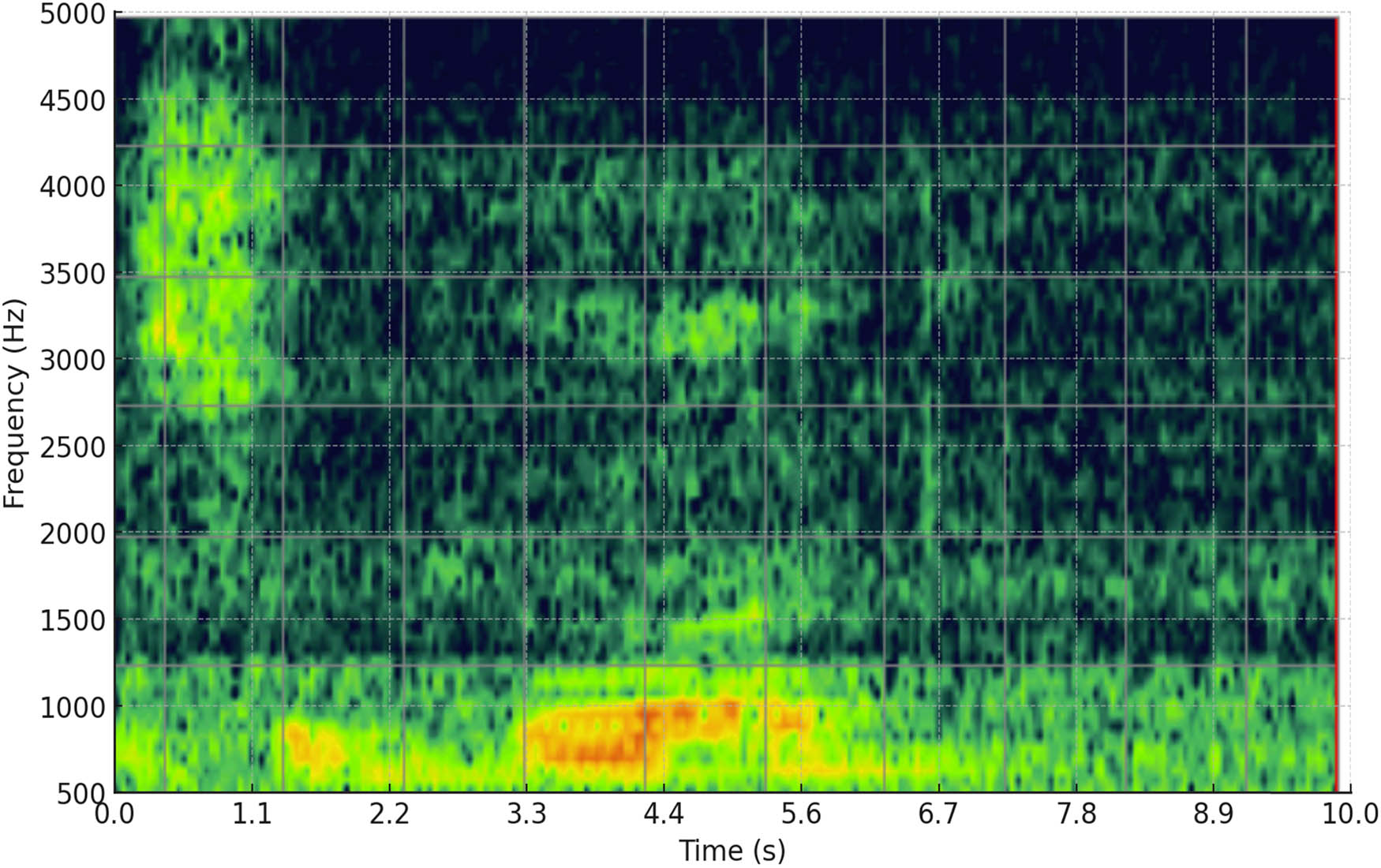
A sample of the production of the syllable /∫u/ by an individual with AOS.
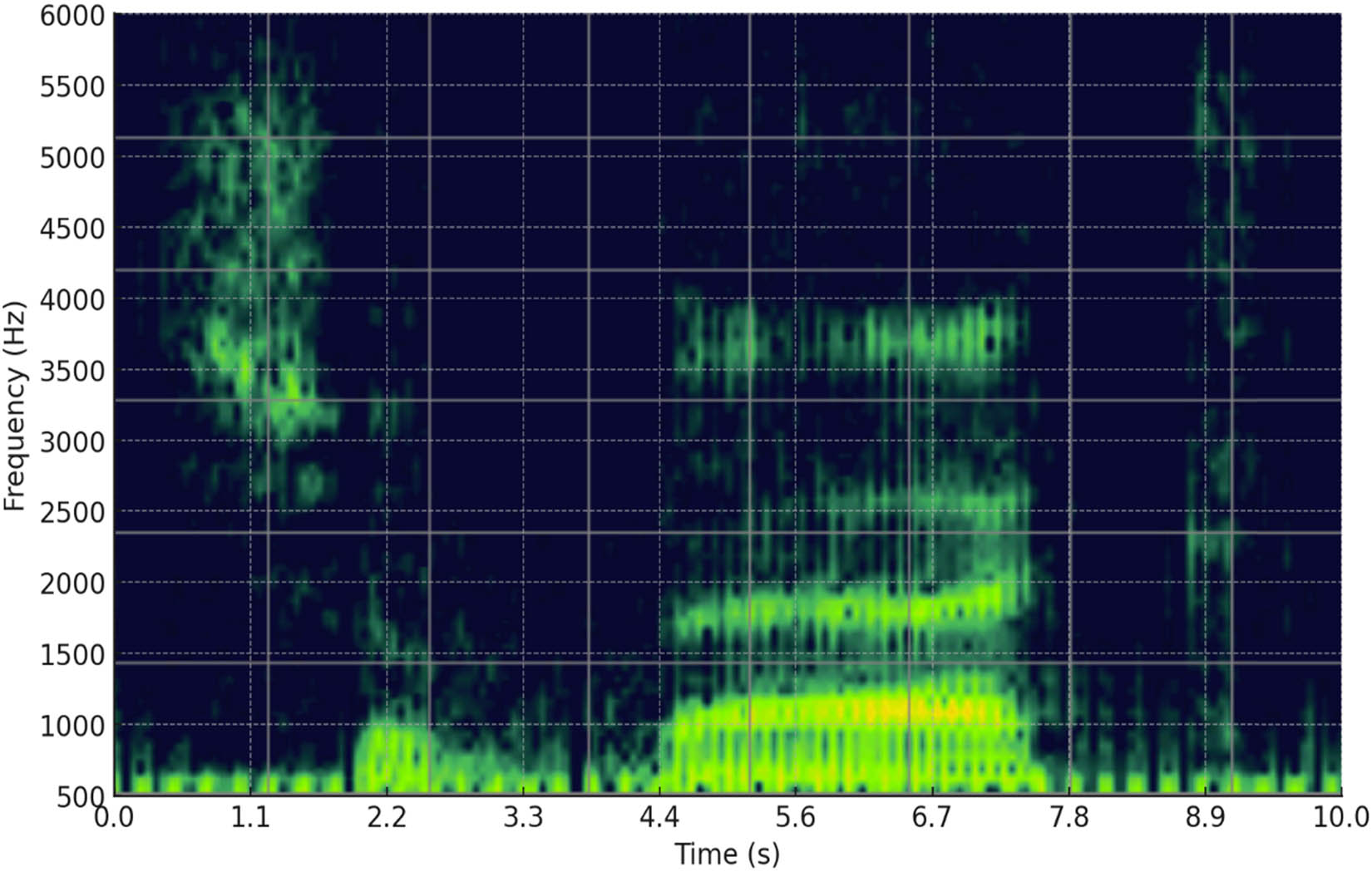
A sample of the production of the syllable /∫u/ as produced by a control speaker.
A Palestinian Arabic-speaking SLP pronounced each target word, which participants repeated five times, resulting in 120 utterances per group (12 words × 5 repetitions × 2 participants). Healthy speakers produced the same number of repetitions. To ensure consistency, participants were instructed to maintain a typical pitch and loudness. A brief practice session was conducted before recording to familiarize participants with the task.
3.3 Recording procedures
Recordings were conducted in a quiet room with a high-quality AKG Perception 120 USB microphone, placed 15 cm from the participants’ mouths to minimize distortion. Speech samples were captured at 44 kHz (16-bit quantization) and low-pass filtered at 16 kHz for acoustic analysis. If a participant had difficulty producing a target word, the examiner would repeat the prompt before resuming the recording.
3.4 Acoustic measurements
Duration measurements for the initial fricatives and vowel segments were conducted using a wideband spectrogram and waveform. The onset and offset of noise were used as reference points to mark the beginning and end of each fricative. The fricative onset was identified by the concentration of high-frequency energy in the spectrogram, while the fricative offset was defined as the point of minimum intensity immediately before the onset of the following vowel (Jongman et al. 2000). Thus, fricative duration was measured as the interval between the fricative’s onset and offset.
Following Haley et al. (2001), mean spectral analysis was conducted using a 20-ms window centered 50 ms after fricative onset, employing PRAAT software (Boersma and Weenink 2020). This interval, shown to provide reliable spectral distinctions for AOS-related studies, was selected to enhance the differentiation of fricative sounds. Formant frequencies (F1 and F2) for vowels following the initial fricatives were automatically extracted using PRAAT and Phono Lab software (Metoui 1995).
To plot the acoustic vowel space, formant normalization was performed using the Visible Vowels software (Heeringa and van de Velde 2020) to reduce inter-speaker variability due to physiological differences in vocal tract configuration (Vorperian and Kent 2014). The acoustic analysis applied Lobanov’s z-score normalization method (Lobanov 1971). The COG, or first spectral moment (M1), in Hz, was calculated using TF32 software, based on three 50-ms windows of fricative noise with a 25-ms overlap between successive windows (Kim 2017).
The use of three overlapping 50-ms windows improved temporal resolution, enabling a more precise capture of spectral changes within the fricative sounds. The fricative intensity was measured by calculating the average intensity of each test segment in decibels (dB), and the intensity difference between the fricative and the following vowel was used as a dependent variable.
3.5 Statistical analysis
A two-way analysis of variance (ANOVA) was conducted to examine the effects of speaker group (AOS vs control) and fricative type (/s/ vs /ʃ/) on segment duration, intensity, spectral characteristics, and formant frequencies (F1, F2, and F3). For vowel-related measures, vowel category (/aː/, /uː/, /iː/) was included as an additional independent factor. The analysis assessed main effects and interactions for each acoustic measure. Post hoc tests were not conducted because the ANOVA did not reveal significant interactions that warranted further pairwise comparisons. Instead, we interpreted the main effects directly based on the ANOVA results.
4 Results
4.1 Segment duration
Table 4 presents the mean durations (in milliseconds) of fricatives and vowels, along with their corresponding intensity values (dB). A two-way ANOVA revealed a significant main effect of the speaker group (F(1,10) = 123.884, p < 0.001), with AOS participants producing significantly longer fricative durations compared to controls. A main effect of fricative type was also found (F(1,10) = 70.098, p < 0.05), indicating that /ʃ/ was consistently longer than /s/ in both groups. However, no significant interaction effect was observed between speaker group and fricative type (F(1,10) = 77.233, p > 0.05), suggesting that AOS participants maintained durational contrasts between the two fricatives.
Duration (ms) of vowels (/aː/, /uː/, /iː/) and fricatives, along with intensity values (dB) for healthy speakers (HS) and speakers with AOS
| Duration (ms) | Intensity (dB) | ||||
|---|---|---|---|---|---|
| Fricative Gr. | Fricative | Vowel | Fricative | Vowel | Difference between vowel and fricative |
| /s/ HS | 110.69 | 175.77 | 76.02 | 66.87 | 9.15 |
| AOS | 120.34 | 213.18 | 52.22 | 47.98 | 4.24 |
| /∫/ HS | 135.42 | 180.33 | 67.22 | 54.01 | 13.2 |
| AOS | 213.45 | 247.32 | 48.54 | 44.55 | 3.99 |
Vowel duration also differed significantly between groups. Levene’s test for equality of variances showed significant differences following /s/ (F(1,10) = 38.423, p < 0.001) and /ʃ/ (F(1,10) = 0.043, p < 0.001), with AOS speakers producing longer vowels than controls. A two-factor ANOVA confirmed a significant effect of place of articulation on fricative duration for both /s/ (F(1,10) = 7.706, p = 0.02) and /ʃ/ (F(1,10) = 302.001, p < 0.001), reinforcing the idea that motor planning impairments in AOS contribute to prolonged segment durations.
4.2 Intensity
The intensity of vowels and fricatives was analyzed and compared between healthy speakers and speakers with AOS, as shown in Table 4 and Figures 3 and 4. Levene’s test for equality of variances revealed a significant difference between the speaker groups in terms of vowel intensity following the fricatives /s/ (F(1,10) = 0.454, p < 0.001) and /ʃ/ (F(1,10) = 0.887, p < 0.001). Analysis of fricative intensity also showed significant differences between healthy speakers and speakers with AOS for both /s/ (F(1,10) = 0.092, p < 0.001) and /ʃ/ (F(1,10) = 1.269, p < 0.001).
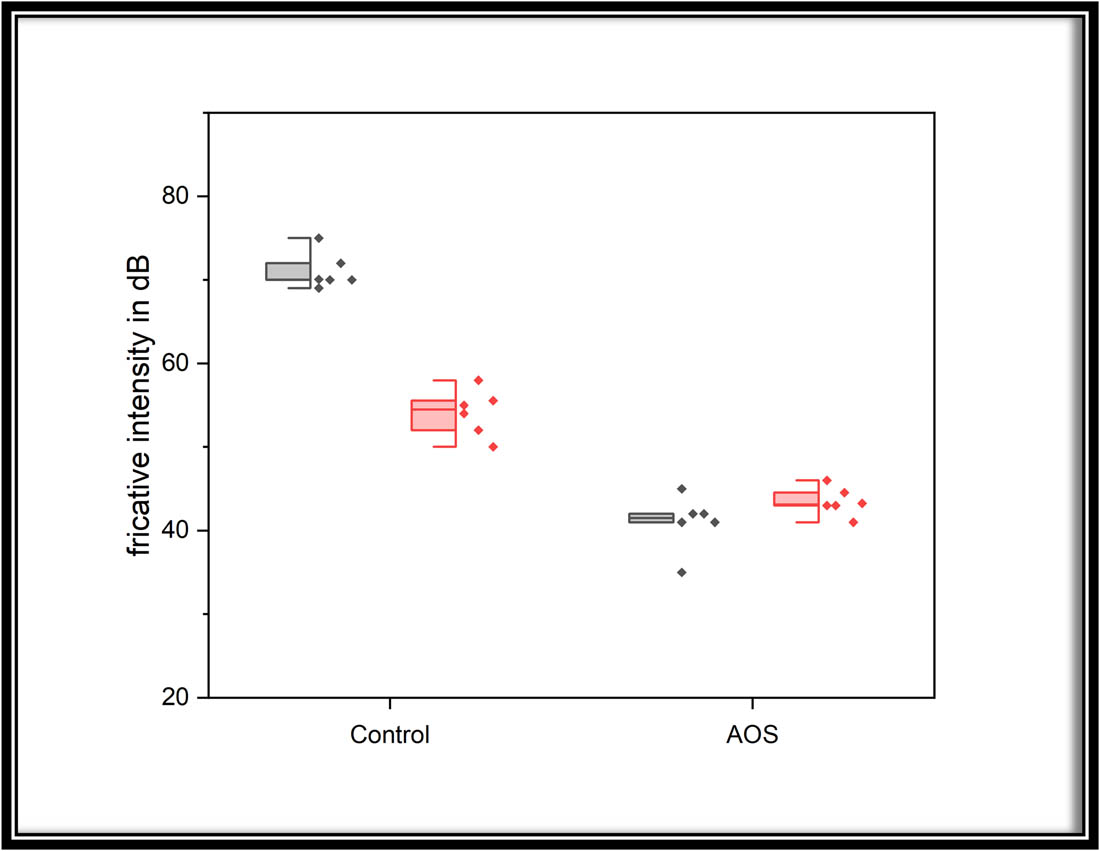
Intensity values (dB) for /s/ and /ʃ/ as produced by control speakers and speakers with AOS.
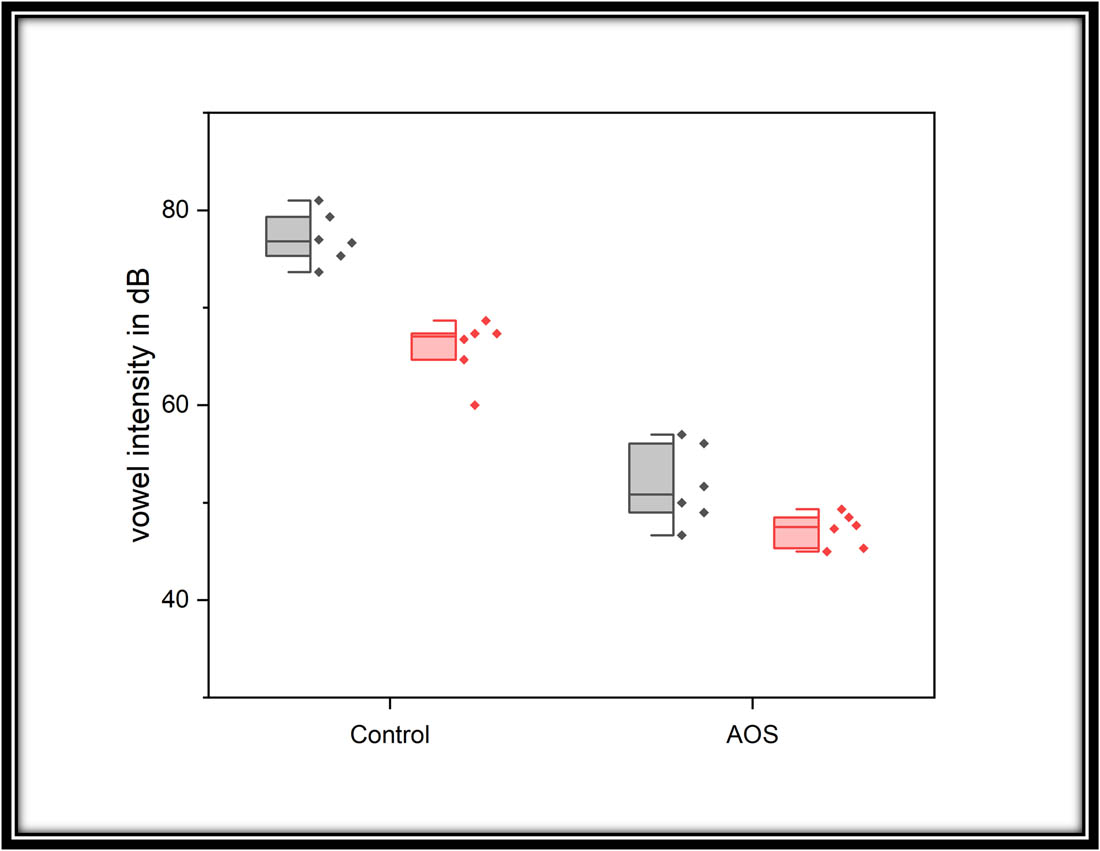
Vowel intensity values (dB) following /s/ and /ʃ/ as produced by control speakers and speakers with AOS.
For speakers with AOS, the intensity difference was more pronounced for /s/, whereas for healthy speakers, it was greater for /ʃ/. A two-factor ANOVA revealed a significant effect on vowel intensity following /s/ (F(1,10) = 61.936, p < 0.001) and /ʃ/ (F(1,10) = 74.711, p < 0.001). Similarly, significant effects were found for the intensity of the fricatives themselves, with both /s/ (F(1,10) = 346.782, p < 0.001) and /ʃ/ (F(1,10) = 63.298, p < 0.001) showing significant results.
A two-way ANOVA revealed a significant effect of fricative type (F(1,10) = 44.356, p < 0.05), indicating that mean spectral peaks differed between /s/ and /ʃ/ across speaker groups. In addition, individuals with AOS exhibited significantly lower mean spectral peaks compared to controls (F(1,10) = 5.087, p < 0.01). Further analysis confirmed group differences for both /s/ (F(1,10) = 77.22, p < 0.001) and /ʃ/ (F(1,10) = 40.798, p < 0.001), suggesting reduced articulatory precision in AOS.
Despite lower spectral peaks, AOS speakers maintained similar overall spectral patterns to the control group. No significant interaction effect of fricative type and speaker group was found (F(4.41) = 55.10, p > 0.05), indicating consistent spectral differences across conditions. As expected, the spectral mean of /s/ was consistently higher than /ʃ/ in both groups. Specifically, AOS speakers exhibited acoustic energy concentrations for /s/ in the 1,100–4,900 Hz range, while for /ʃ/, energy ranged from 830 to 4,900 Hz. In contrast, healthy speakers showed higher energy distributions, with /s/ ranging from 5,000 to 6,000 Hz and /ʃ/ between 4,800 and 5,980 Hz. These findings align with previous research indicating that sibilant fricatives exhibit robust spectral and temporal properties (Harmes et al. 1984), particularly in healthy speech, where /s/ demonstrates a strong high-frequency concentration.
The formant frequencies (F1, F2, and F3) were analyzed for all vowels and compared between AOS and control speakers. Only significant and relevant differences are reported. Figures 5–7 illustrate the F1, F2, and F3 values for each vowel category across groups.
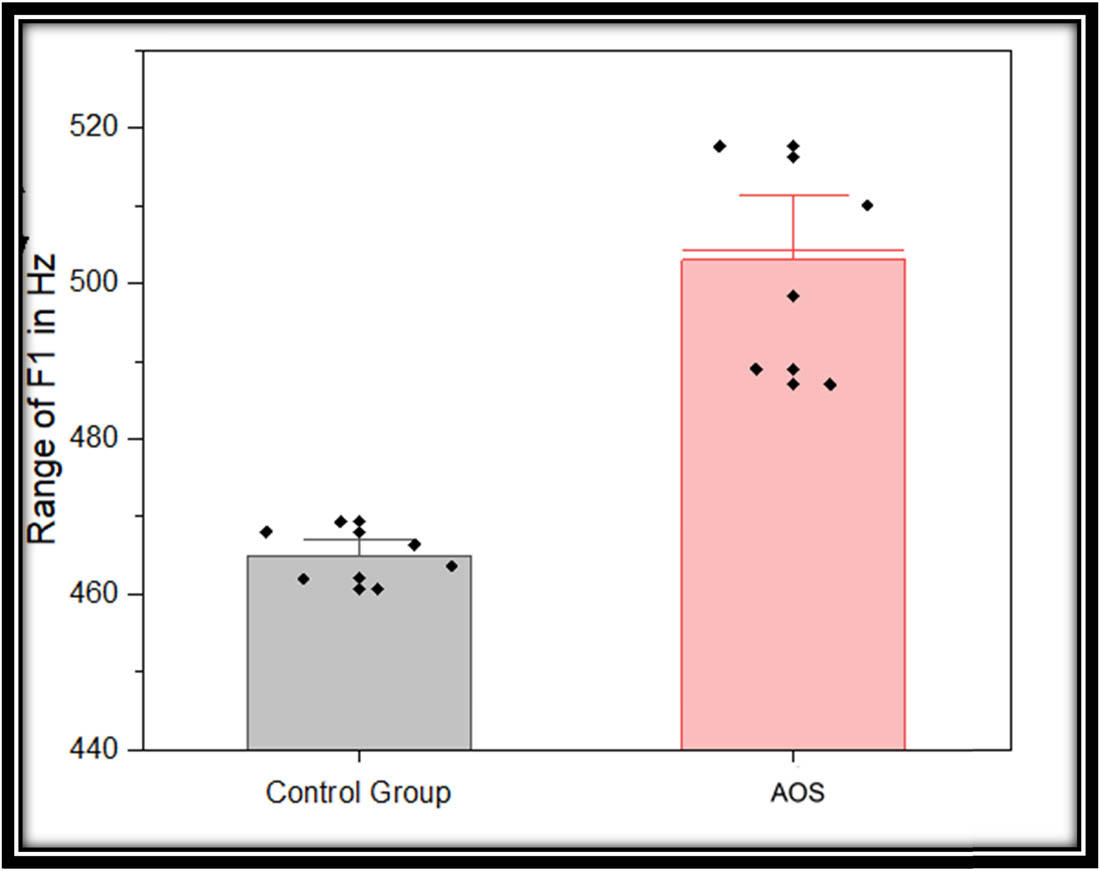
F1 values (Hz) for the vowels (/a:, u:, i:/) following /s/ and /∫/ produced by the control group and speakers with AOS.
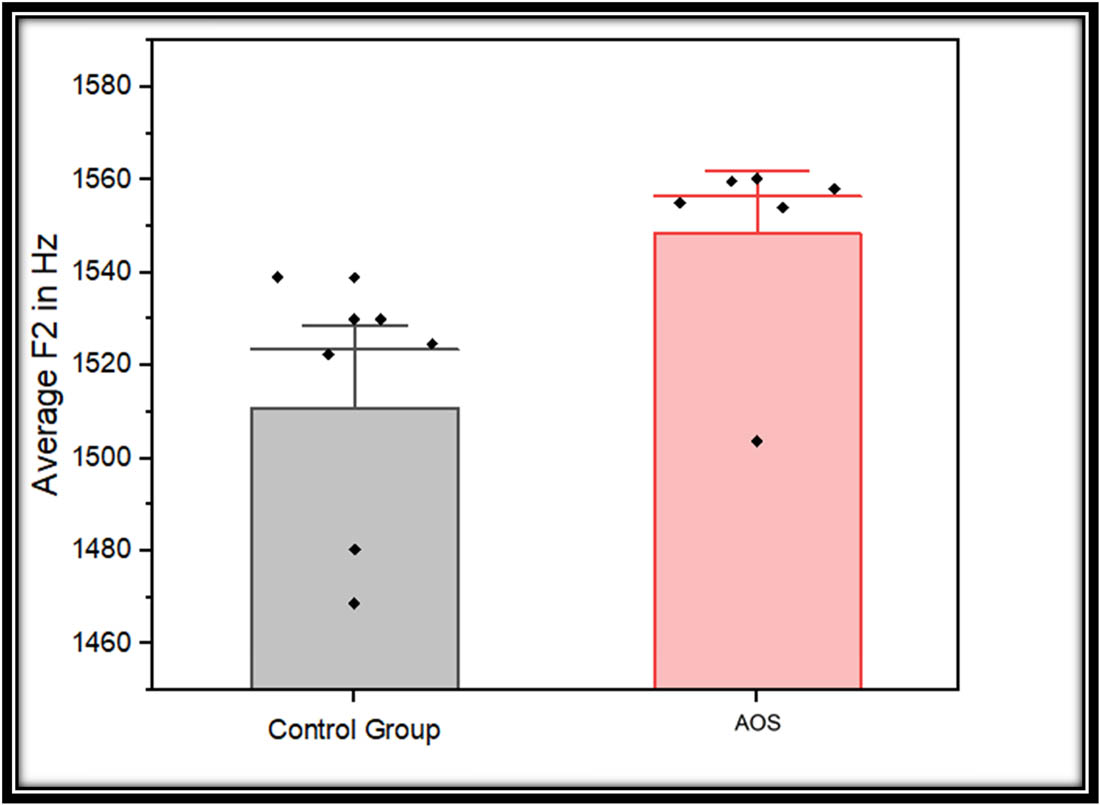
F2 values (Hz) for the vowels (/a:, u:, i:/) following /s/ and /∫/ produced by the control group and speakers with AOS.
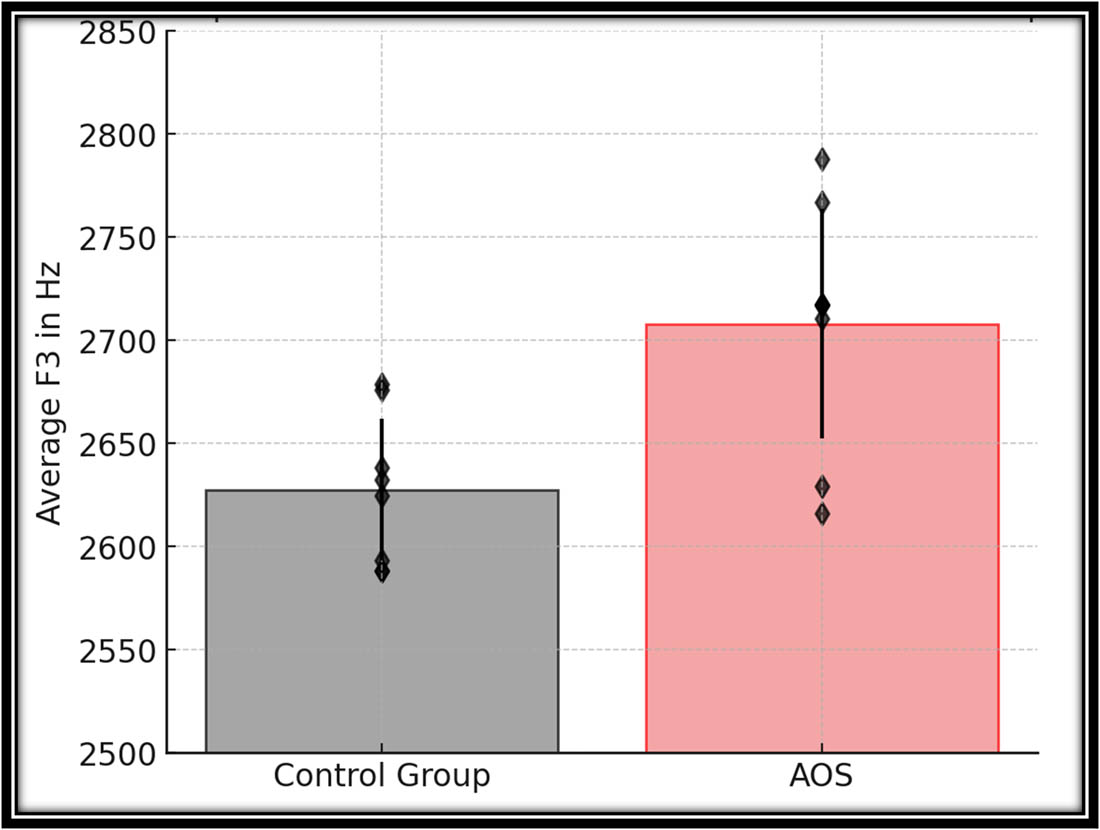
F3 values (Hz) for the vowels (/a:, u:, i:/) following /s/ and /∫/ produced by the control group and speakers with AOS.
For /aː/, Levene’s test for F1 variances showed no significant difference between groups (F(1,10) = 0.015, p > 0.05). However, a two-way ANOVA revealed a significant main effect of the speaker group on F1 (F(1,10) = 411.897, p < 0.001), indicating altered tongue height in AOS. A similar trend was observed for F2, where Levene’s test suggested equal variances across groups (F(1,10) = 1.803, p > 0.05), but a significant between-group difference was detected (F(1,10) = 129.112, p < 0.001), suggesting changes in tongue advancement.
For /uː/, both F1 (F(1,10) = 33.015, p < 0.05) and F2 (F(1,10) = 18.642, p < 0.001) were significantly different between groups, reflecting potential instability in vowel articulation in AOS. Similarly, for /iː/, a significant effect was observed for F1 (F(1,10) = 54.399, p < 0.001), while F2 differences were nonsignificant (F(1,10) = 0.007, p > 0.05), indicating that tongue height was more affected than tongue advancement in AOS speakers.
F3 analysis revealed some differences between groups, but these were less consistent than F1 and F2. For /aː/, a two-way ANOVA showed a significant difference in F3 values (F(1,10) = 87.542, p < 0.001), suggesting variability in vocal tract shaping. However, for /iː/, the difference in F3 was only marginally significant (F(1,10) = 34.221, p < 0.01), and for /uː/, while differences were observed (F(1,10) = 42.378, p < 0.01), the variability in F3 across participants was higher than in F1 and F2. These results indicate that while AOS may influence finer articulatory adjustments reflected in F3, its role is less systematic compared to F1 and F2.
These findings suggest that individuals with AOS may have difficulty achieving accurate mouth positioning, which could lead to higher F1 values for the back vowel /uː/ compared to the front vowel /iː/ (p < 0.05). The significant differences in F3 indicate potential instability in vocal tract shaping, but the inconsistencies across vowels suggest that F3 is not as reliable as F1 and F2 in characterizing vowel production deficits in AOS. Despite these variations, speakers with AOS were able to produce distinct vowel categories without acoustic overlap, as shown in Figure 5.
4.3 COG
The analysis showed that the first spectral moment (M1) was higher for /s/ than for /ʃ/ in both speaker groups, indicating a main effect of the word. A two-way ANOVA revealed a significant effect for the COG and fricative type (F(4.567, 357.324) = 6.986, p > 0.05), suggesting that the mean COG values significantly differed between fricative types, regardless of the speaker group. An independent samples t-test further confirmed significant differences in COG mean values between the speaker groups, with /s/ (F(1,10) = 7.732, p < 0.05, P = 0.022) and /ʃ/ (F(1,10) = 13.311, p < 0.05, P = 0.004) both showing significant results. Compared to healthy speakers, individuals with AOS demonstrated lower intensity and lower COG mean values for both fricatives /s/ and /ʃ/, as shown in Figure 8.
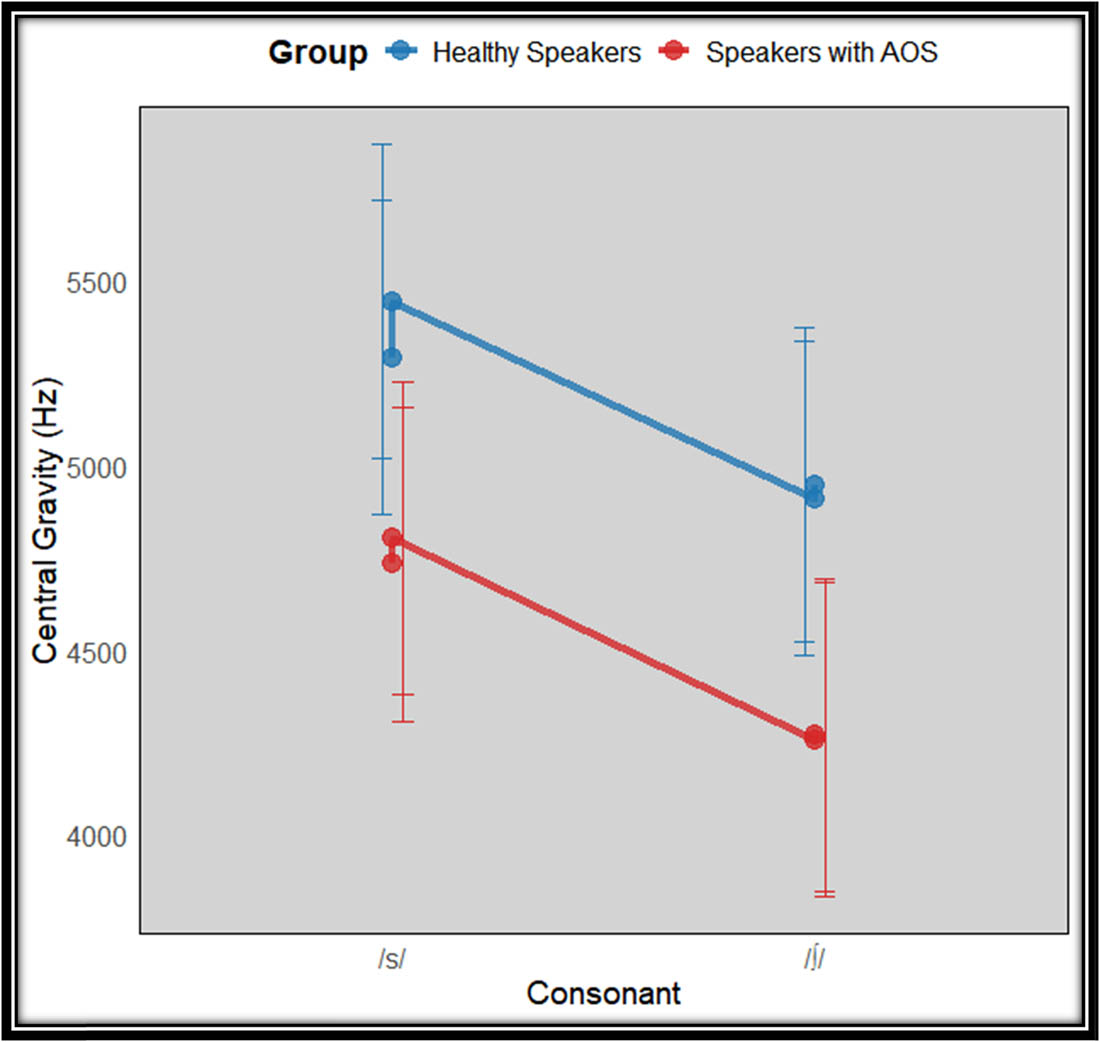
Mean of fricative central gravity as produced by speakers with AOS and HS.
5 Discussion
The present study examined the acoustic properties of fricatives and vowels in Palestinian Arabic-speaking individuals with AOS, revealing significant differences in segment duration, intensity, spectral characteristics, and formant frequencies compared to healthy speakers. These findings reinforce the notion that AOS disrupts articulatory precision and motor coordination, affecting both fricative production and vowel articulation.
As Figure 9 illustrates, speakers with AOS exhibited markedly longer segment durations than controls, consistent with previous studies identifying timing deficits as a core feature of AOS (Kent and Rosenbek 1983, Botha and Josephs 2019, Allison et al. 2020). As shown in Table 4, fricative durations in AOS speakers were nearly twice as long as those of the control group (F(1,10) = 123.884, p < 0.001), reflecting slowed articulatory transitions and impaired motor planning. More notably, vowel durations were even more prolonged than fricative durations, particularly following /s/ and /ʃ/, with significant between-group differences (F(1,10) = 38.423, p < 0.001 for /s/; F(1,10) = 0.043, p < 0.001 for /ʃ/).
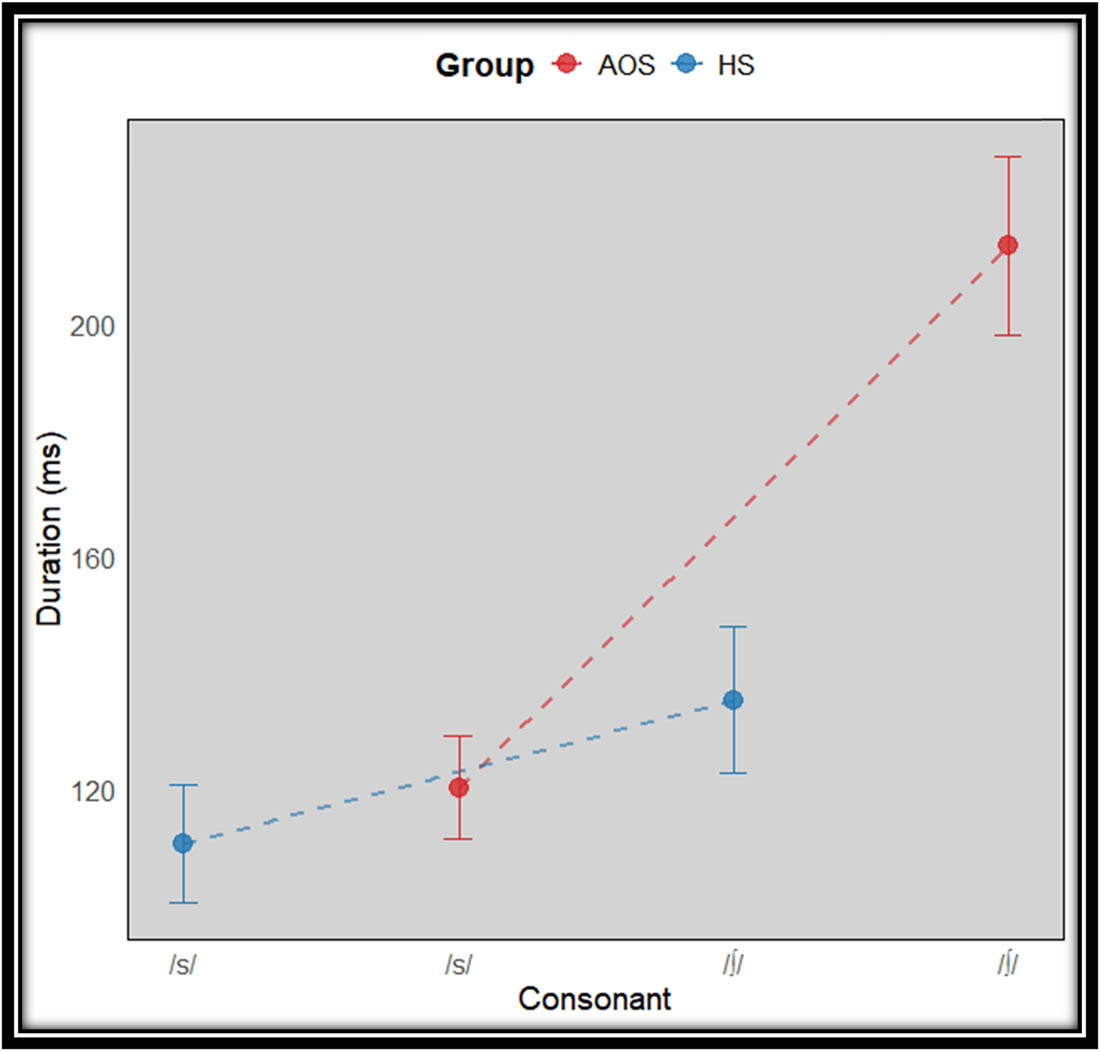
Fricative duration (ms) for /s/ and /ʃ/ by speaker group.
Although this study focused on the fricatives /s/ and /ʃ/, the complexity of Arabic phonology, particularly the presence of emphatic sounds, which are also known as pharyngealized consonants, such as /sˤ/, /tˤ/, and /ðˤ/, may present additional articulatory challenges in AOS. These sounds require precise tongue root retraction and laryngeal coordination, which could further complicate motor planning in individuals with AOS. Future studies should investigate whether AOS affects emphatic fricatives differently than their nonemphatic counterparts to refine our understanding of motor speech deficits in Arabic speakers.
This pattern suggests that vowel articulation requires greater control in AOS, possibly due to heightened articulatory uncertainty or reliance on compensatory adjustments. The observed vowel lengthening contrasts with findings by Ryalls (1981), who reported similar vowel durations in AOS and control speakers. The discrepancy may be due to methodological differences, variation in AOS severity, or linguistic factors, underscoring the need for standardized experimental protocols in AOS research to ensure comparability across studies.
Despite overall segment prolongation, speakers with AOS maintained durational contrasts between /s/ and /ʃ/, as indicated by a significant main effect of fricative type (F(1,10) = 70.098, p < 0.05) but no interaction with the speaker group (F(1,10) = 77.233, p > 0.05). This suggests that while AOS disrupts global timing control, certain phonemic contrasts remain distinguishable, supporting previous research, indicating that AOS affects movement fluency rather than the phonemic structure (Ziegler 2008, Duffy et al. 2020).
Cross-linguistic comparisons further highlight how AOS affects fricative production across languages. In English and German, AOS disrupts articulatory precision in complex consonant clusters, while in Spanish, fricative duration does not significantly differentiate AOS from controls – a finding that contrasts with our Arabic results, where significant durational differences were observed (Ziegler 2002, Duffy 2013, Ballard et al. 2015, Pérez et al. 2019, Melle et al. 2024). In addition, Spanish AOS speakers exhibit greater articulatory variability in rounded vowels (Pérez et al. 2019). These differences underscore the role of language-specific phonetic and articulatory demands in shaping AOS speech patterns and highlight the need for tailored assessment approaches across linguistic contexts.
Vowel formant analysis further revealed significant group differences in F1 and F2 values, indicating altered tongue positioning and vocal tract shaping. AOS speakers produced abnormal formant positioning, particularly in /uː/, where both F1 and F2 deviated significantly from control values (F(1,10) = 33.015, p < 0.05 for F1; F(1,10) = 18.642, p < 0.001 for F2), as illustrated in Figures 5 and 6.
These findings suggest constraints in oral configuration and difficulty achieving precise articulatory targets. However, an important observation is that vowel spaces remained well separated, with no category overlap in AOS speakers (Figure 10). This supports the argument that AOS speakers may rely on compensatory articulation to preserve phonemic contrasts, even when motor execution is impaired (Jacks 2006).
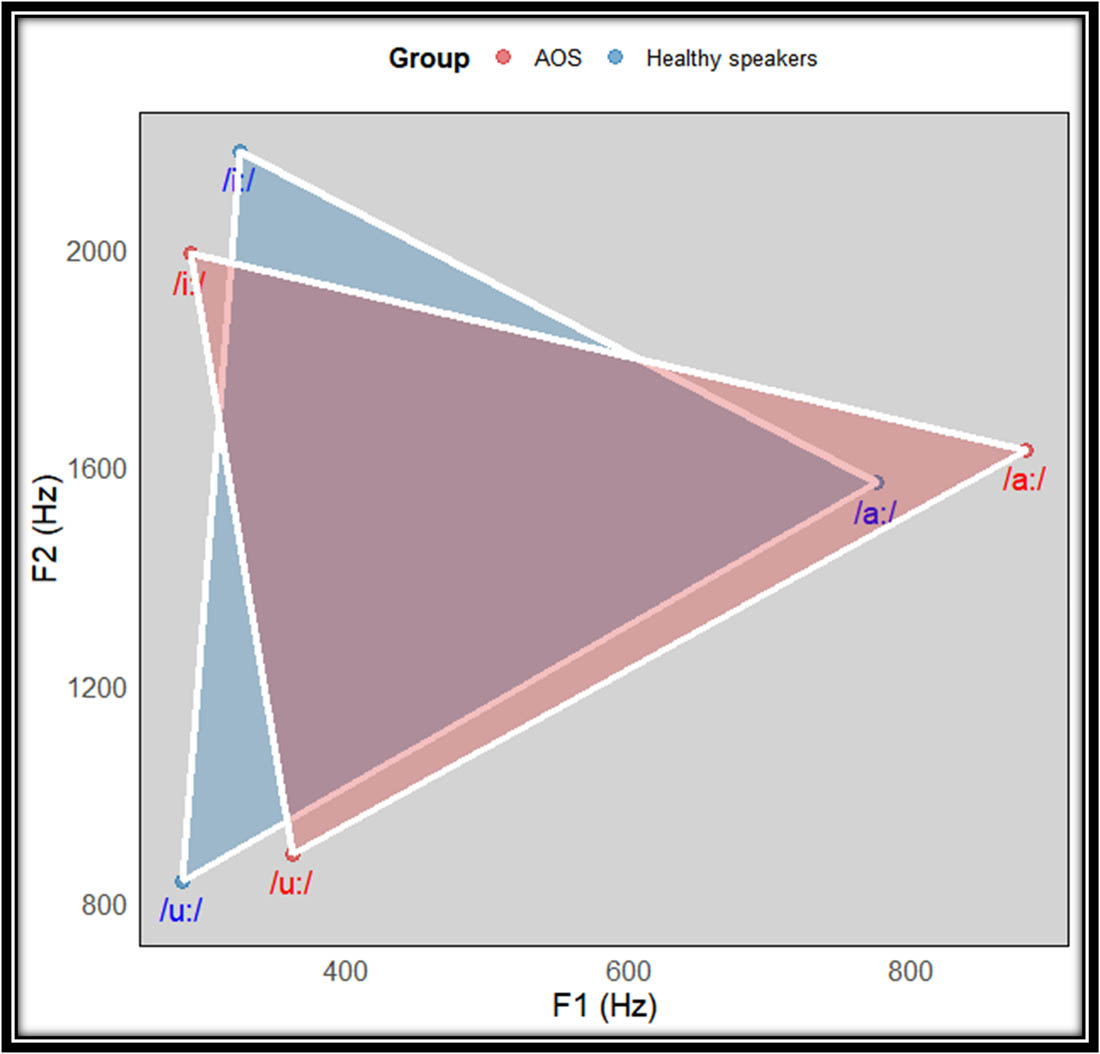
Acoustic vowel space as produced by speakers with AOS and healthy speakers (HS).
While most AOS research has focused on Indo-European languages, emerging studies on Hebrew – a Semitic language like Arabic – highlight the critical role of phonological complexity, syllable structure, and root-based morphology in shaping speech motor planning (Ziegler et al. 2010, Miller 2006). Hebrew speakers with AOS exhibit notable vowel space centralization and reduced formant distinctiveness (F1, F2), which are strongly associated with decreased intelligibility (Carl and Icht 2021). These findings suggest that prosodic and morphophonological features of Semitic languages may influence how AOS manifests, underscoring the need for cross-linguistic research to inform more accurate diagnosis and intervention for speakers of Arabic and related languages.
Despite this, the significant variability in F1 for /iː/ (F(1,10) = 54.399, p < 0.001) suggests underlying instability in vowel articulation, which may become more pronounced in spontaneous or multisyllabic speech contexts (Haley et al. 2001). In addition, while F3 analysis showed some differences between groups, its variability across vowels suggests that it is not as reliable as F1 and F2 for characterizing vowel production deficits in AOS. Since F3 is more closely associated with vocal tract shaping rather than primary articulatory movements, its relevance to AOS-related motor speech deficits appears to be limited.
Speakers with AOS also exhibited significantly lower intensity values for both fricatives and vowels, contributing to reduced phonetic contrast and potentially affecting speech intelligibility. The intensity difference between fricatives and following vowels was significantly smaller in AOS speakers, confirming difficulties in maintaining phonetic clarity (F(1,10) = 0.454, p < 0.001 for /s/; F(1,10) = 0.887, p < 0.001 for /ʃ/). As shown in Figure 8, the reduction in intensity contrast between consonants and vowels suggests that AOS affects articulatory strength and force, limiting the speaker’s ability to produce clear phonetic distinctions (Tjaden and Martel-Sauvageau 2017).
Spectral analysis further revealed an overlap between /s/ and /ʃ/ in AOS speakers, where the higher-frequency energy of /s/ shifted downward, encroaching on the spectral range of /ʃ/. This spectral shift suggests reduced articulatory precision, which may blur phonemic boundaries, reinforcing the idea that AOS affects fine articulatory adjustments necessary for speech clarity.
Spectral characteristics provide additional evidence of articulatory instability in AOS. Lower COG values indicate a shift toward lower-frequency energy, confirming weakened tongue positioning and imprecise articulatory targeting (F(1,10) = 7.732, p < 0.05, P = 0.022 for /s/; F(1,10) = 13.311, p < 0.05, P = 0.004 for /ʃ/). As illustrated in Figure 8, AOS speakers produced flatter spectral peaks, which may reflect insufficient anterior tongue placement or weaker airflow control during fricative production.
These findings align with the previous research demonstrating that AOS speakers struggle to generate high-frequency fricatives, leading to weaker spectral energy (Duffy 2013, Duffy et al. 2020, Kim 2017). Importantly, voicing contrasts remained intact in the analyzed fricatives, with no evidence of voicing distortions in /s/. However, since /z/ was not included in the dataset, direct conclusions about its production in AOS cannot be made. This suggests that AOS primarily disrupts fine motor tuning rather than phonological voicing control, reinforcing findings that certain linguistic contrasts remain preserved even when motor execution is impaired.
6 Limitations of the study
This study offers valuable insights into the acoustic features of AOS in Arabic speakers, but several limitations should be acknowledged. The small sample size (two male speakers) restricts the generalizability of findings. Future research should include a more diverse participant group, particularly female speakers, to improve applicability. In addition, the focus on controlled speech tasks may not fully capture AOS in natural communication. Examining spontaneous speech would provide a more comprehensive understanding of its impact on articulation and motor planning. While this study focused on /s/ and /ʃ/ due to their articulatory complexity and acoustic properties, other Arabic fricatives were not examined. Future research should explore a broader range of fricatives to provide a more comprehensive understanding of AOS-related speech impairments and refine diagnostic criteria.
Linguistic factors, such as dialectal variations, were not considered, which may influence AOS speech patterns. Future studies should explore these differences to ensure broader applicability across Arabic-speaking populations. Finally, given the scarcity of AOS research in Arabic speakers, there is a need for culturally and linguistically tailored diagnostic and therapeutic approaches. Expanding clinical studies will help refine assessment tools and intervention strategies.
7 Conclusion
The main goal of this study was to examine the acoustic characteristics of sibilant fricatives /s/ and /ʃ/ in Arabic-speaking individuals with AOS, revealing significant differences from healthy speakers in both temporal and spectral domains. Individuals with AOS exhibited longer segment durations, lower mean spectral peaks, reduced intensity, and decreased energy concentration frequencies for /s/ and /ʃ/. The reduced COG (M1) further indicated difficulties in achieving the precise articulatory configurations required for clear, high-frequency fricative production.
The deviations observed in F1 and F2 values suggest some differences in vowel production between groups, but vowel articulation appeared relatively preserved in AOS. These findings reinforce the view that AOS primarily disrupts consonant articulation due to the greater complexity of motor control required for consonant production. Overall, this study highlights AOS as a disorder characterized by articulatory instability, prolonged durations, and reduced spectral clarity, particularly in fricative sounds. These findings contribute to a better understanding of AOS in Arabic speakers and underscore the need for further research on its acoustic features.
-
Funding information: The author states no funding involved.
-
Author contributions: The author confirms the sole responsibility for the conception of the study, results presentation, and manuscript preparation.
-
Conflict of interest: The author states no conflict of interest.
-
Informed consent: In accordance with ethical guidelines, informed consent was obtained from all participants prior to their involvement in the research. The privacy rights of individuals were strictly upheld throughout the study. We adhered to the principles outlined in the Declaration of Helsinki and the Recommendations for the Conduct, Reporting, Editing, and Publication of Scholarly Work. Our research included representative populations based on sex, age, and ethnicity. Throughout the research process, we rigorously safeguarded the privacy and confidentiality of participants to protect their personal information. We confirm that our study complies with all ethical standards and guidelines, ensuring that the rights and well-being of participants were prioritized.
-
Data availability statement: Due to participant privacy and confidentiality concerns, the data generated and analyzed during this study are not publicly available. The participants have not provided consent for sharing their data beyond the study’s scope. In accordance with institutional ethics guidelines and confidentiality agreements, any inquiries regarding the data may be directed to the corresponding author.
References
Allison, Kristen M. 2020. “Measuring Speech Intelligibility in Children with Motor Speech Disorders.” American Speech-Language-Hearing Association 5: 809–20. 10.1044/2020_persp-19-00110.Search in Google Scholar
Allison, Kristen M., Claire Cordella, Jenya Iuzzini-Seigel, and Jordan R. Green. 2020. “Differential Diagnosis of Apraxia of Speech in Children and Adults: A Scoping Review.” Journal of Speech, Language, and Hearing Research 63: 2952–94. 10.1044/2020_jslhr-20-00061.Search in Google Scholar
Ballard, Kirrie J., Deborah A. Robin, and Patricia McCabe. 2015. “A Cross-Linguistic Perspective on Speech Motor Control Disorders.” Journal of Communication Disorders 53: 1–13.Search in Google Scholar
Bislick, Lauren and William D. Hula. 2019. “Perceptual Characteristics of Consonant Production in Apraxia of Speech and Aphasia.” American Journal of Speech-Language Pathology 28: 1411–38. 10.1044/2019_ajslp-18-0169.Search in Google Scholar
Boersma, Paul and David Weenink. 2020. Praat: Doing Phonetics by Computer, Version 6.1.16. Computer program. http://www.praat.org.Search in Google Scholar
Botha, Hanlie and Keith Josephs. 2019. “Primary Progressive Aphasias and Apraxia of Speech.” Continuum: Lifelong Learning in Neurology 25: 101–27. 10.1212/con.0000000000000699.Search in Google Scholar
Bunker, Lisa D., Dallin J. Bailey, Elaine Poss, Shannon Mauszycki, and Julie L. Wambaugh. 2024. “Stability over Time of Word Syllable Duration for Speakers with Acquired Apraxia of Speech.” Journal of Speech, Language, and Hearing Research 67: 4038–52. 10.1044/2024_JSLHR-23-00007.Search in Google Scholar
Carl, Micalle and Michal Icht. 2021. “Acoustic Vowel Analysis and Speech Intelligibility in Young Adult Hebrew Speakers: Developmental Dysarthria versus Typical Development.” International Journal of Language & Communication Disorders 56: 283–98. https://onlinelibrary.wiley.com/doi/10.1111/1460-6984.12598.10.1111/1460-6984.12598Search in Google Scholar
Chen, Helen and Kenneth N. Stevens. 2001. “An Acoustical Study of the Fricative /s/ in the Speech of Individuals with Dysarthria.” Journal of Speech, Language, and Hearing Research 44: 1300–14. 10.1044/1092-4388(2001/101).Search in Google Scholar
Dabul, Bruce. 2000. Apraxia Battery for Adults, Second Edition. Austin, TX: Pro-Ed.Search in Google Scholar
Duffy, Joseph R., Rene L. Utianski, and Keith A. Josephs. 2020. “Primary Progressive Apraxia of Speech: From Recognition to Diagnosis and Care.” Aphasiology 35: 1–32. 10.1080/02687038.2020.1787732.Search in Google Scholar
Duffy, Joseph. 2006. “Apraxia of Speech in Degenerative Neurologic Disease.” Aphasiology 20: 511–27. 10.1080/02687030600597358.Search in Google Scholar
Duffy, Joseph. 2013. Motor Speech Disorders: Substrates, Differential Diagnosis, and Management. 3rd ed. New York: Mosby.Search in Google Scholar
Forrest, Karen, Gary Weismer, Paul Milenkovic, and Ronald N. Dougall. 1988. “Statistical Analysis of Word-Initial Voiceless Obstruents: Preliminary Data.” Journal of the Acoustical Society of America 84: 115–23. 10.1121/1.396977.Search in Google Scholar
Haley, Katheleen, Adam Jacks, Julia Richardson, Gretchen Harmon, Hannah Lacey, and Paul Turkeltaub. 2023. “Do People with Apraxia of Speech and Aphasia Improve or Worsen across Repeated Sequential Word Trials?” Journal of Speech, Language, and Hearing Research 66: 1240–51. 10.1044/2022_JSLHR-22-00438.Search in Google Scholar
Haley, Katheleen, Erin Seelinger, Kelsey Callahan, and Daniel Zajac. 2010. “Evaluating the Spectral Distinction between Sibilant Fricatives through a Speaker-Centered Approach.” Journal of Phonetics 38: 548–54. 10.1016/j.wocn.2010.07.006.Search in Google Scholar
Haley, Katheleen, Gregory Bays, and Ralph Ohde. 2001. “Phonetic Properties of Aphasic-Apraxic Speech: A Modified Narrow Transcription Analysis.” Aphasiology 15: 1125–42. 10.1080/02687040143000537.Search in Google Scholar
Haley, Katheleen, Ralph Ohde, and Robert Wertz. 2001. “Vowel Quality in Aphasia and Apraxia of Speech: Phonetic Transcription and Formant Analyses.” Aphasiology 15: 1107–23. 10.1080/02687040143000519.Search in Google Scholar
Harmes, Sharon, Raymond G. Daniloff, Paul R. Hoffman, Jeffrey Lewis, Mitchell B. Kramer, and Richard Absher. 1984. “Temporal and Articulatory Control of Fricative Articulation by Speakers with Broca’s Aphasia.” Journal of Phonetics 12: 367–85. 10.1016/s0095-4470(19)30897-6.Search in Google Scholar
Heeringa, Wilbert and Hans van de Velde. 2020. Visible Vowels [computer program]. Accessed Month Day, Year. https://www.visiblevowels.org/.Search in Google Scholar
Jacks, Adam, Katey A. Mathes, and Thomas P. Marquardt. 2010. “Vowel Acoustics in Adults with Apraxia of Speech.” Journal of Speech, Language, and Hearing Research 53: 61–74. 10.1044/1092-4388(2009/08-0017).Search in Google Scholar
Jacks, Adam. 2006. “Vowel Targeting and Perception in Apraxia of Speech.” PhD diss., University of Texas at Austin.Search in Google Scholar
Jongman, Allard, Ratree Wayland, and Serena Wong. 2000. “Acoustic Characteristics of English Fricatives.” Journal of the Acoustical Society of America 108: 1252–63. 10.1121/1.1288413.Search in Google Scholar
Kempler, Daniel and Diana Van Lancker. 2002. “The Effect of Speech Task on Intelligibility in Dysarthria: Case Study of Parkinson’s Disease.” Brain and Language 80: 449–64. 10.1006/brln.2001.2602.Search in Google Scholar
Kent, Raymond and John Rosenbek. 1983. “Acoustic Patterns of Apraxia of Speech.” Journal of Speech and Hearing Research 26: 231–49. 10.1044/jshr.2602.231.Search in Google Scholar
Kim, Yunjung and Chia-Ying Kuo. 2011. “Effect of Level of Presentation to Listeners on Scaled Speech Intelligibility of Speakers with Dysarthria.” Folia Phoniatrica et Logopaedica 64: 26–33. 10.1159/000328642.Search in Google Scholar
Kim, Yunjung. 2017. “Acoustic Characteristics of Fricatives /s/ and/ʃ/ Produced by Speakers with Parkinson’s Disease.” Clinical Archive of Communication Disorders 2: 7–14. 10.21849/cacd.2016.00080.Search in Google Scholar
Lobanov, Boris. 1971. “Classification of Russian Vowels Spoken by Different Speakers.” Journal of the Acoustical Society of America 49: 606–8. 10.1121/1.1912396.Search in Google Scholar
Maas, Edwin and Marja-Liisa Mailend. 2017. “Fricative Contrast and Coarticulation in Children with and without Speech Sound Disorders.” American Journal of Speech-Language Pathology 26: 649–63. 10.1044/2017_ajslp-16-0110.Search in Google Scholar
Manaf, Nazia A. and Rohila Shetty. 2022. “Western Aphasia Battery – Arabic.” Language in India 22 (10). Accessed Month Day, Year. http://www.languageinindia.com.Search in Google Scholar
McNeil, Malcolm, Deborah Robin, and Richard Schmidt. 2009. “Apraxia of Speech.” In Clinical Management of Sensorimotor Speech Disorders, edited by Malcolm R. McNeil, 2nd ed., 249–68. Thieme.Search in Google Scholar
Melle, Natalia, Carlos Gallego, José María Lahoz-Bengoechea, and Silvia Nieva. 2024. “Differential Spectral Characteristics of the Spanish Fricative /s/ in the Articulation of Individuals with Dysarthria and Apraxia of Speech.” Journal of Communication Disorders 109: 106428. 10.1016/j.jcomdis.2024.106428.Search in Google Scholar
Metoui, Mongi. 1995. “Phono Lab: Computer Program zur Artikulatorisch-Akustischen Datenanalyse.” Arbeitsberichte des Instituts für Allgemeine und Vergleichende Sprachwissenschaft der Universität Mainz 1: 1–100.Search in Google Scholar
Metoui, Mongi. 2001. Strategien der Artikulation über die Steuerungsprozesse des Sprechens. Aachen: Shaker Verlag.Search in Google Scholar
Miller, Paul. 2006. “Processing Unpointed Hebrew: What Can We Learn from Determining the Identicalness of Monosyllabic and Bisyllabic Nouns?” Journal of Psycholinguistic Research 35 (3): 267–83. 10.1007/S10936-006-9015.Search in Google Scholar
Nittrouer, Susan. 1995. “Children Learn Separate Aspects of Speech Production at Different Rates: Evidence from Spectral Moments.” Journal of the Acoustical Society of America 97: 520–30. 10.1121/1.412278.Search in Google Scholar
Park, Jin. 2017. “Apraxia: Review and Update.” Journal of Clinical Neurology 13: 317–24. 10.3988/jcn.2017.13.4.317.Search in Google Scholar
Pérez, Antonio, Javier Hernández, and Manuel Iglesias. 2019. “Spanish-Speaking Patients with Apraxia of Speech: Phonological and Morphological Challenges.” Neurolinguistics Journal 35: 112–26. 10.1044/0161-1461(2004/002).Search in Google Scholar
Pickett, James. 1999. The Acoustics of Speech Communication. Boston: Allyn and Bacon.Search in Google Scholar
Ryalls, John. 1981. “Motor Aphasia: Acoustic Correlates of Phonetic Disintegration in Vowels.” Neuropsychologia 19: 365–74. 10.1016/0028-3932(81)90066-x.Search in Google Scholar
Ryalls, John. 1986. “An Acoustic Study of Vowel Production in Aphasia.” Brain & Language 29: 48–67. 10.1016/0093-934x(86)90033-7.Search in Google Scholar
Shadle, Christine. 2012. “Acoustics and Aerodynamics of Fricatives.” In Handbook of Laboratory Phonology, edited by Abigail Cohn, Cécile Fougeron, and Marie Huffman, 511–26. New York: Oxford University Press.Search in Google Scholar
Square-Storer, Patricia and Saskia Apeldoorn. 1991. “An Acoustic Study of Apraxia of Speech in Patients with Different Lesion Loci.” In Dysarthria and Apraxia of Speech: Perspectives on Management, edited by Christopher A. Moore, Kathryn M. Yorkston, and David R. Beukelman, 271–88. Baltimore, MD: Paul H. Brookes.Search in Google Scholar
Staiger, Anja, Wolfgang Finger-Berg, Ingella Aichert, and Wolfgang Ziegler. 2012. “Error Variability in Apraxia of Speech: A Matter of Controversy.” Journal of Speech, Language, and Hearing Research 55: 1544–61. 10.1044/1092-4388(2012/11-0319).Search in Google Scholar
Tjaden, Kimberly and Véronique Martel-Sauvageau. 2017. “Consonant Acoustics in Parkinson’s Disease and Multiple Sclerosis: Comparison of Clear and Loud Speaking Conditions.” American Journal of Speech-Language Pathology 26: 569–82. 10.1044/2017_ajslp-16-0090.Search in Google Scholar
Vorperian, Houri and Raymond Kent. 2014. “Development of the Acoustic Vowel Quadrilateral: Normative Data and a Clinical Application.” Poster presented at the Motor Speech Conference, Sarasota, FL.Search in Google Scholar
Wambaugh, Julie L., Carrie Nessler, Rosalea Cameron, and Shannon C. Mauszycki. 2013. “Treatment for Acquired Apraxia of Speech: Examination of Treatment Intensity and Practice Schedule.” American Journal of Speech-Language Pathology 22 (1): 84–102. 10.1044/1058-0360(2012/12-0025).Search in Google Scholar
Ziegler, Wolfgang, Ingella Aichert, and Anja Staiger. 2010. “Syllable- and Rhythm-Based Approaches in the Treatment of Apraxia of Speech.” Perspectives on Neurophysiology and Neurogenic Speech and Language Disorders 20 (3): 59–66. 10.1044/NNSLD20.3.59.Search in Google Scholar
Ziegler, Wolfgang. 2002. “Speech Motor Control in Developmental and Acquired Disorders: A German Perspective.” Clinical Linguistics & Phonetics 16 (6): 505–22. 10.3109/02699209008985496.Search in Google Scholar
Ziegler, Wolfgang. 2008. “Effectiveness of Metrical Pacing in the Treatment of Apraxia of Speech.” Aphasiology 22: 77–102. 10.1080/02687030600965464.Search in Google Scholar
© 2025 the author(s), published by De Gruyter
This work is licensed under the Creative Commons Attribution 4.0 International License.
Articles in the same Issue
- Research Articles
- No three productions alike: Lexical variability, situated dynamics, and path dependence in task-based corpora
- Individual differences in event experiences and psychosocial factors as drivers for perceived linguistic change following occupational major life events
- Is GIVE reliable for genealogical relatedness? A case study of extricable etyma of GIVE in Huī Chinese
- Borrowing or code-switching? Single-word English prepositions in Hong Kong Cantonese
- Stress and epenthesis in a Jordanian Arabic dialect: Opacity and Harmonic Serialism
- Can reading habits affect metaphor evaluation? Exploring key relations
- Acoustic properties of fricatives /s/ and /∫/ produced by speakers with apraxia of speech: Preliminary findings from Arabic
- Translation strategies for Arabic stylistic shifts of personal pronouns in Indonesian translation of the Quran
- Colour terms and bilingualism: An experimental study of Russian and Tatar
- Argumentation in recommender dialogue agents (ARDA): An unexpected journey from Pragmatics to conversational agents
- Toward a comprehensive framework for tonal analysis: Yangru tone in Southern Min
- Variation in the formant of ethno-regional varieties in Nigerian English vowels
- Cognitive effects of grammatical gender in L2 acquisition of Spanish: Replicability and reliability of object categorization
- Interaction of the differential object marker pam with other prominence hierarchies in syntax in German Sign Language (DGS)
- Modality in the Albanian language: A corpus-based analysis of administrative discourse
- Theory of ecology of pressures as a tool for classifying language shift in bilingual communities
- BSL signers combine different semiotic strategies to negate clauses
- Embodiment in colloquial Arabic proverbs: A cognitive linguistic perspective
- Voice quality has robust visual associations in English and Japanese speakers
- Special Issue: Request for confirmation sequences across ten languages, edited by Martin Pfeiffer & Katharina König - Part II
- Request for confirmation sequences in Castilian Spanish
- A coding scheme for request for confirmation sequences across languages
- Special Issue: Classifier Handshape Choice in Sign Languages of the World, coordinated by Vadim Kimmelman, Carl Börstell, Pia Simper-Allen, & Giorgia Zorzi
- Classifier handshape choice in Russian Sign Language and Sign Language of the Netherlands
- Formal and functional factors in classifier choice: Evidence from American Sign Language and Danish Sign Language
- Choice of handshape and classifier type in placement verbs in American Sign Language
- Somatosensory iconicity: Insights from sighted signers and blind gesturers
- Diachronic changes the Nicaraguan sign language classifier system: Semantic and phonological factors
- Depicting handshapes for animate referents in Swedish Sign Language
- A ministry of (not-so-silly) walks: Investigating classifier handshapes for animate referents in DGS
- Choice of classifier handshape in Catalan Sign Language: A corpus study
Articles in the same Issue
- Research Articles
- No three productions alike: Lexical variability, situated dynamics, and path dependence in task-based corpora
- Individual differences in event experiences and psychosocial factors as drivers for perceived linguistic change following occupational major life events
- Is GIVE reliable for genealogical relatedness? A case study of extricable etyma of GIVE in Huī Chinese
- Borrowing or code-switching? Single-word English prepositions in Hong Kong Cantonese
- Stress and epenthesis in a Jordanian Arabic dialect: Opacity and Harmonic Serialism
- Can reading habits affect metaphor evaluation? Exploring key relations
- Acoustic properties of fricatives /s/ and /∫/ produced by speakers with apraxia of speech: Preliminary findings from Arabic
- Translation strategies for Arabic stylistic shifts of personal pronouns in Indonesian translation of the Quran
- Colour terms and bilingualism: An experimental study of Russian and Tatar
- Argumentation in recommender dialogue agents (ARDA): An unexpected journey from Pragmatics to conversational agents
- Toward a comprehensive framework for tonal analysis: Yangru tone in Southern Min
- Variation in the formant of ethno-regional varieties in Nigerian English vowels
- Cognitive effects of grammatical gender in L2 acquisition of Spanish: Replicability and reliability of object categorization
- Interaction of the differential object marker pam with other prominence hierarchies in syntax in German Sign Language (DGS)
- Modality in the Albanian language: A corpus-based analysis of administrative discourse
- Theory of ecology of pressures as a tool for classifying language shift in bilingual communities
- BSL signers combine different semiotic strategies to negate clauses
- Embodiment in colloquial Arabic proverbs: A cognitive linguistic perspective
- Voice quality has robust visual associations in English and Japanese speakers
- Special Issue: Request for confirmation sequences across ten languages, edited by Martin Pfeiffer & Katharina König - Part II
- Request for confirmation sequences in Castilian Spanish
- A coding scheme for request for confirmation sequences across languages
- Special Issue: Classifier Handshape Choice in Sign Languages of the World, coordinated by Vadim Kimmelman, Carl Börstell, Pia Simper-Allen, & Giorgia Zorzi
- Classifier handshape choice in Russian Sign Language and Sign Language of the Netherlands
- Formal and functional factors in classifier choice: Evidence from American Sign Language and Danish Sign Language
- Choice of handshape and classifier type in placement verbs in American Sign Language
- Somatosensory iconicity: Insights from sighted signers and blind gesturers
- Diachronic changes the Nicaraguan sign language classifier system: Semantic and phonological factors
- Depicting handshapes for animate referents in Swedish Sign Language
- A ministry of (not-so-silly) walks: Investigating classifier handshapes for animate referents in DGS
- Choice of classifier handshape in Catalan Sign Language: A corpus study

